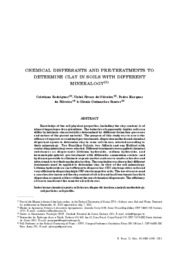Chemical dispersants and pre-treatments to determine clay in soils with different mineralogy.
Chemical dispersants and pre-treatments to determine clay in soils with different mineralogy.
Author(s): RODRIGUES, C.; OLIVEIRA, V. A. de; SILVEIRA, P. M. da; SANTOS, G. G.
Summary: Knowledge of the soil physical properties, including the clay content, is of utmost importance for agriculture. The behavior of apparently similar soils can differ in intrinsic characteristics determined by different formation processes and nature of the parent material. The purpose of this study was to assess the efficacy of separate or combined pre-treatments, dispersion methods and chemical dispersant agents to determine clay in some soil classes, selected according to their mineralogy. Two Brazilian Oxisols, two Alfisols and one Mollisol with contrasting mineralogy were selected. Different treatments were applied: chemical substances as dispersants (lithium hydroxide, sodium hydroxide, and hexametaphosphate); pre-treatment with dithionite, ammonium oxalate, and hydrogen peroxide to eliminate organic matter; and coarse sand as abrasive and ultrasound, to test their mechanical action. The conclusion was drawn that different treatments must be applied to determine clay, in view of the soil mineralogy. Lithium hydroxide was not efficient to disperse low-CEC electropositive soils and very efficient in dispersing high-CEC electronegative soils. The use of coarse sand as an abrasive increased the clay content of all soils and in all treatments in which dispersion occurred, with or without the use of chemical dispersants. The efficiency of coarse sand is not the same for all soil classes.
Publication year: 2011
Types of publication: Journal article
Unit: Embrapa Rice & Beans
Observation
Some of Embrapa's publications are published as ePub files. To read them, use or download one of the following free software options to your computer or mobile device. Android: Google Play Books; IOS: iBooks; Windows and Linux: Calibre.
Access other publications
Access the Agricultural Research Database (BDPA) to consult Embrapa's full library collection and records.
Visit Embrapa Bookstore to purchase books and other publications sold by Embrapa.

